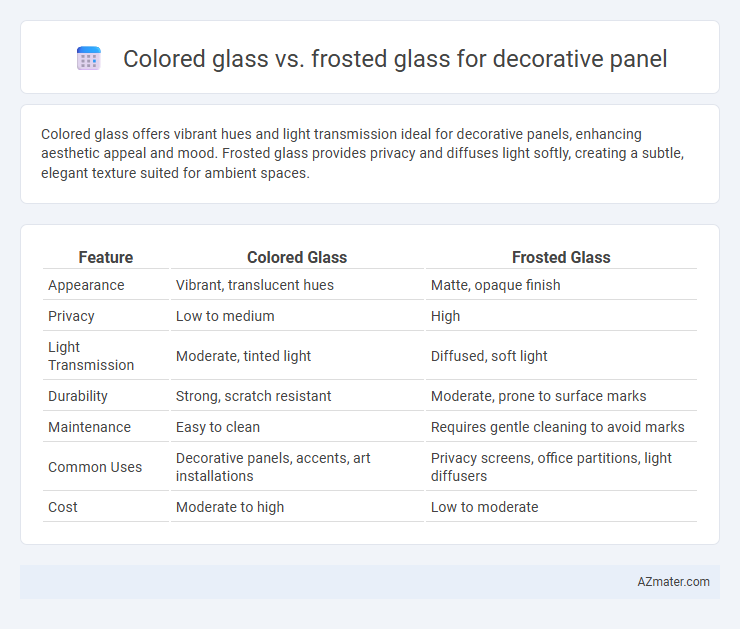Colored glass offers vibrant hues and light transmission ideal for decorative panels, enhancing aesthetic appeal and mood. Frosted glass provides privacy and diffuses light softly, creating a subtle, elegant texture suited for ambient spaces.
Table of Comparison
| Feature | Colored Glass | Frosted Glass |
|---|---|---|
| Appearance | Vibrant, translucent hues | Matte, opaque finish |
| Privacy | Low to medium | High |
| Light Transmission | Moderate, tinted light | Diffused, soft light |
| Durability | Strong, scratch resistant | Moderate, prone to surface marks |
| Maintenance | Easy to clean | Requires gentle cleaning to avoid marks |
| Common Uses | Decorative panels, accents, art installations | Privacy screens, office partitions, light diffusers |
| Cost | Moderate to high | Low to moderate |
Introduction to Glass Decoration Options
Colored glass offers vibrant hues and customizable transparency, enhancing decorative panels with bold visual impact and artistic expression. Frosted glass provides a subtle, matte finish that diffuses light while maintaining privacy, ideal for creating soft ambiance and understated elegance. Both options serve diverse design needs, balancing aesthetics and functionality in interior and architectural applications.
Overview of Colored Glass
Colored glass offers vibrant, translucent hues achieved through the addition of metal oxides, enhancing the aesthetic appeal of decorative panels while allowing natural light to filter through. Its durability and resistance to fading make it an ideal choice for both interior and exterior applications, providing a striking visual element without compromising functionality. Compared to frosted glass, colored glass emphasizes bold color saturation and light dynamics rather than opacity and texture.
Overview of Frosted Glass
Frosted glass offers a translucent surface achieved through sandblasting or acid etching, providing privacy while allowing light to pass through, making it ideal for decorative panels in both residential and commercial spaces. Its matte finish helps to diffuse light evenly and reduces glare, enhancing ambient lighting without sacrificing aesthetics. Compared to colored glass, frosted glass emphasizes subtlety and texture rather than bold color, making it a versatile choice for modern interior design.
Aesthetics and Visual Impact
Colored glass panels provide vibrant hues and dynamic light interplay, enhancing interior spaces with bold visual statements and personalized style. Frosted glass offers a soft, muted aesthetic that diffuses light gently, creating a subtle ambiance while ensuring privacy. Both options elevate decorative panels, with colored glass emphasizing vividness and frosted glass prioritizing understated elegance.
Privacy and Light Diffusion
Colored glass panels provide vibrant hues while maintaining moderate privacy by obscuring clear visibility, making them ideal for decorative applications where color impact is desired alongside light transmission. Frosted glass panels excel in privacy by effectively diffusing light and preventing clear images from passing through, ensuring soft, evenly distributed illumination without compromising brightness. Choosing between colored and frosted glass depends on the balance needed between aesthetic color expression and enhanced privacy through light diffusion in interior design.
Durability and Maintenance
Colored glass offers high durability due to its more robust pigmentation process, resisting fading and scratches better than frosted glass. Frosted glass, created by acid-etching or sandblasting, tends to be more prone to surface damage and requires gentler cleaning methods to maintain its appearance. Both types demand regular maintenance, but colored glass generally withstands harsh cleaning agents and environmental exposure more effectively.
Customization and Design Flexibility
Colored glass offers vibrant customization options with a wide palette of hues and dynamic translucency levels, allowing designers to create striking decorative panels tailored to specific aesthetic themes. Frosted glass provides subtle elegance and enhanced privacy through controlled light diffusion, enabling versatile design patterns via sandblasting or acid etching techniques. Both materials support creative panel designs, but colored glass excels in bold visual statements while frosted glass delivers understated sophistication and texture variety.
Cost Comparison
Colored glass panels generally incur higher initial costs due to specialized pigmentation processes and custom manufacturing requirements, whereas frosted glass panels are more cost-effective, benefiting from simpler acid-etching or sandblasting techniques. Maintenance expenses for both remain relatively low, but any color damage or fading in colored glass may increase long-term costs compared to the consistently neutral appearance of frosted glass. When budgeting for decorative panels, choosing frosted glass often results in lower upfront and lifecycle costs, making it a budget-friendly option for large-scale or cost-sensitive projects.
Ideal Applications for Each Type
Colored glass excels in vibrant interior settings such as feature walls, retail displays, and artistic partitions, where bold visual impact and customizable hues enhance the ambiance. Frosted glass is ideal for privacy-focused applications like office dividers, bathroom panels, and conference rooms, offering diffused light transmission while maintaining confidentiality. Selecting between colored and frosted glass depends on balancing aesthetic appeal with functional requirements for light diffusion and privacy.
Choosing the Right Glass for Your Space
Colored glass offers vibrant hues that enhance modern decorative panels by adding bold visual interest and complementing contemporary interiors. Frosted glass provides a subtle, translucent finish that diffuses light softly, ideal for creating privacy while maintaining brightness in office partitions or bathroom panels. Selecting between colored and frosted glass depends on space requirements for light control, privacy level, and the desired aesthetic impact within the environment.

Infographic: Colored glass vs Frosted glass for Decorative panel
 azmater.com
azmater.com